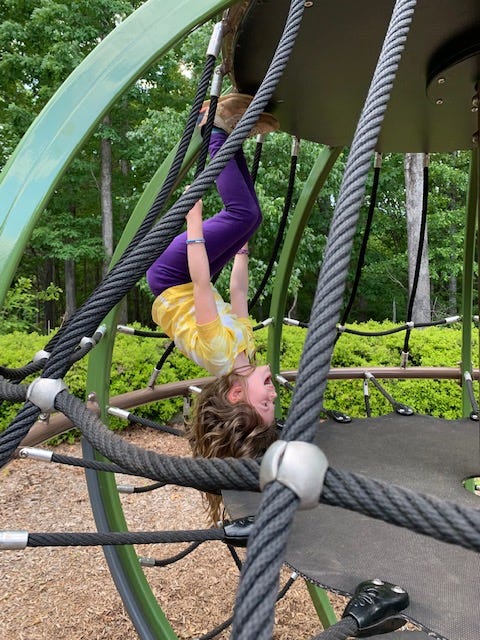Good morning!
This weekend tie-dye project will not hurt your rivers, streams, fish, or wildlife—not with the dye it uses, anyway! Turmeric! It makes a beautiful, earthy yellow-orange that fades to a sunny yellow, and you probably already have it in your pantry.
Here is how to tie-dye a T-shirt (or other cotton fabric) with turmeric:
1. Choose a white or light-colored 100% cotton T-shirt. It’s great to tie-dye something that needs new life, but we happened to have two plain white T-shirts.
2. Wash or soak the T-shirt in hot water if it hasn’t been washed. This will help prepare it for tie-dyeing.
3. Bind your tee in rubber bands, tie-dye style. We had some rubber bands saved from various grocery store items, but not enough, so we used a few hair ties too. They worked great, didn’t transfer their colors, and can still be used after tie-dyeing. You could also use twine.
4. Next, dissolve 2-4 tablespoons of alum in a cup of hot tap water. We used 3 tablespoons for two small T-shirts. Then, add your alum-water to a non-reactive (stainless or enamel) pot of water, with just enough water to submerge the T-shirt. Add the T-shirt, and simmer for about an hour. This is called mordanting the fabric, which helps the dye stick to the fibers.
5. After about an hour, remove the shirt, and drain it in a colander. Discard the alum water.
6. While you’re waiting for the fabric to cool, simmer another 2-4 tablespoons of turmeric in enough water to submerge the fabric again.
7. When the mordanted fabric is cool, wring out the water. Don’t remove the ties/rubber bands. Submerge your fabric in the turmeric water and simmer for 1-2 hours, keeping an eye on the water level. The longer you simmer, the darker/more vibrant your tie-dye will be. You can also turn the stove off after an hour, and just let the fabric soak—even overnight. But we are not that patient. We simmered for one hour, soaked for one.
8. Carefully remove your T-shirt, drain it, and rinse under cold water. Removing the ties is the most exciting part. Ta-da!
We dried ours on the line, then ran it through the rinse cycle in the washing machine. (We’ll also wash it with darks until we know it’s no longer shedding dye.) Since it’s a natural dye, the color will fade over time, but we like the way both the bright tie-dye and the more faded color looks (see this photo of Bea for a more faded shirt).
For an extension, you can...
-Write or retell your own how-to
-Embroider your shirt (especially nice if you have a pocket)—we used plain, graphic stitches when we did this but Bea’s Mamie is a master embroiderer. Maybe we’ll do more on embroidery in another post?
-Have a fashion show
-Research and experiment with other natural dyes. Richard’s sister and Bea and Harriet’s aunt, Janet Ruhan, is a textiles artist and may pop in to the FTT with some lessons on making and using other natural dyes.
See you Sunday with some thoughts on rivers and oral histories.
In the meantime, here are a few links:
Are you sending your kids to camp this summer? Bea is going to two different day camps after trying out an all-outdoors spring break camp at Clapping Hands Farm. We were so impressed with their Covid safety precautions, including the use of spread-out hula hoops as mask break centers, and Bea had so much fun (almost as great as my birthday! she reported). Here is a useful roundup of questions and answers from the New York Times about Covid & camp.
But what to do if you have unvaccinated kids but are vaccinated yourself is still confusing:


My first Substack subscription was not Letters from an American (though I read that every day too), but Robin Lloyd’s less-frequent, but still essential Smart, Useful Science Stuff about Covid-19, a summary of high-quality news about the pandemic, including a lot of good info about kids and school safety. It was recommended to me by my good friend Cat Warren, a science journalist who is also, by the way, the author of a tremendously great young readers’ book about working dogs, scent, and how dogs perceive the world.
Margaret Roach on a few things you may not know about poison ivy.
This article on why humans share food with animals made us think of our cousin Sam, who feeds a squirrel named Stumpy peanuts every day.
Meera Subramanian’s “The Nature of Plastics” in Orion is another fascinating read, and part of an important series about the impact of petrochemicals on our lives.
Speaking of plastics, does anyone here use Guppyfriend? It’s a laundry bag that reduces the shedding of microfibers from synthetic clothing like fleece and leggings by 86%—improving the lifespan of your clothes and keeping harmful waste out of the watershed. We just learned about it, but it’s on my list.
Have a great weekend! If you have experience with tie-dyeing or making old clothes new again, we’d love to hear about it!
And please continue to spread the word about the FTT—we appreciate it so much!






Next time Miles and I are together, we will definitely use tumeric to tie dye some tee shirts. When I was growing up tie dying became all the rage. The 4 younger Boone kids used a bunch of our dad's undershirts without asking. Needless to say he was not pleased when he went to get dressed one morning and couldn't find a single undershirt, but we had cool shirts for every day of the week.
Wow!!! I love these shirts! Thank you, FTT! ❤️